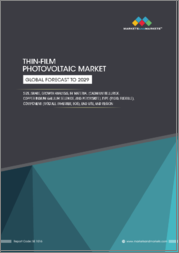
|
시장보고서
상품코드
1581292
박막 태양전지 시장 : 제조 프로세스, 효율, 두께, 재료, 유형, 컴포넌트, 통합 유형, 최종 용도별 - 세계 예측(2025-2030년)Thin-Film Photovoltaic Market by Manufacturing Process (Plating, Printing, Thermal Evaporation), Efficiency (High Efficiency, Low Efficiency, Medium Efficiency), Thickness, Material, Type, Component, Integration Type, End use - Global Forecast 2025-2030 |
||||||
박막 태양전지 시장은 2023년에 57억 9,000만 달러로 평가되며, 2024년에는 65억 2,000만 달러에 달할 것으로 예측되며, CAGR 14.87%로 성장하며, 2030년에는 153억 달러에 달할 것으로 예측됩니다.
박막 태양전지 시장의 유망한 분야인 PV(태양전지) 기술은 기판 위에 매우 얇은 광배터리 재료를 증착하는 기술입니다. 이 혁신적인 접근 방식은 기존의 실리콘 기반 태양전지에 비해 경량화, 유연성, 재료비 절감 등의 이점을 제공합니다. 박막 태양전지의 필요성은 탄소 배출량을 줄이고 에너지 안보를 강화하기 위한 재생 에너지 솔루션에 대한 전 세계적인 수요 증가에 기인합니다. 박막 태양전지는 건축자재, 자동차, 휴대용 기기, 대규모 유틸리티 시설에 통합되는 등 다양한 용도로 활용되고 있습니다. 주요 최종 용도 부문에는 주거, 상업 및 산업 시장이 포함되며, 에너지 효율과 건물일체형 태양광발전(BIPV)이 인기를 끌고 있습니다.
| 주요 시장 통계 | |
|---|---|
| 기준년[2023년] | 57억 9,000만 달러 |
| 예측년[2024년] | 65억 2,000만 달러 |
| 예측년[2030년] | 153억 달러 |
| CAGR(%) | 14.87% |
시장 성장에 영향을 미치는 주요 요인으로는 재료 및 생산 비용의 감소, 기술 발전으로 인한 효율성 향상, 재생에너지 도입을 촉진하는 정부 장려책 및 정책 증가 등이 있습니다. 업계는 아시아태평양, 중동 등 일조량이 풍부하고 환경 규제가 강화된 지역에서 큰 비즈니스 기회가 있을 것으로 보고 있습니다. 기업은 유기 PV 재료와 자동화 제조 공정의 발전을 활용하여 비용을 절감하고 확장성을 더욱 높일 수 있는 방법을 모색해야 합니다. 또한 BIPV 솔루션에 대한 건설사와의 제휴는 새로운 수입원을 창출할 수 있습니다.
그러나 박막 태양전지 시장은 결정질 실리콘 패널에 비해 효율이 낮고, 최종사용자의 인지도가 낮으며, 기존 태양전지 기술과의 경쟁이라는 문제에 직면해 있습니다. 시장 관계자들은 페로브스카이트나 양자점 같은 재료 연구를 통해 효율을 높이고 박막 모듈의 장기적인 신뢰성과 수명을 개선하는 데 집중해야 합니다. 또한 부드럽고 투명한 PV 재료의 혁신은 웨어러블 기술 및 스마트 창문에 대한 통합과 같은 시장 응용을 확대할 수 있습니다. 에너지 변환 효율을 높이고 박막 재료의 지속가능한 재활용 공정을 개발하기 위한 R&D 투자는 실행 가능한 성장 전략입니다. 전반적으로 이 시장은 경쟁 구도에 따라 역동적인 시장이며, 성공의 열쇠는 첨단 재료 연구와 전략적 파트너십을 채택하고 기술 채택을 통해 신흥 시장에 진출할 수 있는지에 달려 있습니다.
시장 역학: 빠르게 진화하는 박막 태양전지 시장의 주요 시장 인사이트 공개
박막 태양전지 시장은 수요 및 공급의 역동적인 상호작용에 의해 변화하고 있습니다. 이러한 시장 역학의 변화를 이해함으로써 기업은 정보에 입각한 투자 결정을 내리고, 전략적인 의사결정을 정교화하며, 새로운 비즈니스 기회를 포착할 수 있습니다. 이러한 동향을 종합적으로 파악함으로써 기업은 정치적, 지역적, 기술적, 사회적, 경제적 영역 전반에 걸친 다양한 리스크를 줄일 수 있으며, 소비자 행동과 그것이 제조 비용 및 구매 동향에 미치는 영향을 보다 명확하게 이해할 수 있습니다.
- 시장 성장 촉진요인
- 환경 문제와 규제 의무화로 인해 전 세계에서 재생에너지에 대한 수요가 증가하고 있습니다.
- 결정 실리콘 태양전지에 비해 생산에 필요한 자원이 적고 비용 효율이 높습니다.
- 박막 태양전지 태양전지의 유연성과 범용성으로 인해 다양한 표면과 제품에 통합 가능
- 시장 성장 억제요인
- 결정질 실리콘 태양전지에 비해 효율이 낮습니다.
- 시장 기회
- 박막 태양전지의 유연성, 경량화, 미적 다양성으로 인해 건물일체형 태양광발전(BIPV)에 통합 가능
- 효율성 향상, 재료비 절감, 혁신적인 박막 기술 발전으로 인한 박막 기술 진보
- 시장 과제
- 제조 공정이 복잡하고 첨단 기술과 장비가 필요함.
Portre's Five Forces: 박막 태양전지 시장 탐색을 위한 전략적 툴
Portre's Five Forces 프레임워크는 시장 상황경쟁 구도를 이해하는 중요한 툴입니다. Portre's Five Forces 프레임워크는 기업의 경쟁을 평가하고 전략적 기회를 모색하기 위한 명확한 방법을 설명합니다. 이 프레임워크는 기업이 시장내 세력도를 평가하고 신규 사업의 수익성을 판단하는 데 도움이 됩니다. 이러한 인사이트을 통해 기업은 강점을 활용하고, 약점을 보완하고, 잠재적 도전을 피함으로써 보다 강력한 시장 포지셔닝을 확보할 수 있습니다.
PESTLE 분석 : 박막 태양전지 시장에서의 외부 영향 파악
외부 거시 환경 요인은 박막 태양전지 시장의 성과 역학을 형성하는 데 매우 중요한 역할을 합니다. 정치적, 경제적, 사회적, 기술적, 법적, 환경적 요인에 대한 분석은 이러한 영향을 탐색하는 데 필요한 정보를 담고 있으며, PESTLE 요인을 조사함으로써 기업은 잠재적인 위험과 기회를 더 잘 이해할 수 있습니다. 이러한 분석을 통해 기업은 규제, 소비자 선호도, 경제 동향의 변화를 예측하고 선제적이고 적극적인 의사결정을 내릴 준비를 할 수 있습니다.
시장 점유율 분석 : 박막 태양전지 시장에서 경쟁 구도 파악
박막 태양전지 시장의 상세한 시장 점유율 분석을 통해 공급업체의 성과를 종합적으로 평가할 수 있습니다. 기업은 매출, 고객 기반, 성장률과 같은 주요 지표를 비교하여 경쟁적 위치를 파악할 수 있습니다. 이 분석은 시장의 집중화, 세분화 및 통합 추세를 파악하여 공급업체가 치열한 경쟁에서 자신의 입지를 강화할 수 있는 전략적 의사결정을 내리는 데 필요한 인사이트을 제공합니다.
FPNV 포지셔닝 매트릭스 박막 태양전지 시장에서공급업체 실적 평가
FPNV 포지셔닝 매트릭스는 박막 태양전지 시장에서 공급업체를 평가하는 중요한 툴입니다. 이 매트릭스를 통해 비즈니스 조직은 벤더의 비즈니스 전략과 제품 만족도를 기반으로 평가하여 목표에 부합하는 정보에 입각한 의사결정을 내릴 수 있으며, 4개의 사분면으로 벤더를 명확하고 정확하게 세분화하여 전략 목표에 가장 적합한 파트너와 솔루션을 식별할 수 있습니다. 전략 목표에 가장 적합한 파트너와 솔루션을 식별할 수 있습니다.
박막 태양전지 시장에서의 성공 전략 분석 및 추천 박막 태양전지 시장에서의 성공 경로를 그리다.
박막 태양전지 시장 전략 분석은 세계 시장에서 입지를 강화하고자 하는 기업에게 필수적입니다. 주요 자원, 역량 및 성과 지표를 검토함으로써 기업은 성장 기회를 식별하고 개선할 수 있습니다. 이러한 접근 방식을 통해 경쟁 환경의 도전을 극복하고 새로운 비즈니스 기회를 활용하여 장기적인 성공을 거둘 수 있도록 준비할 수 있습니다.
이 보고서는 주요 관심 부문에 대한 종합적인 시장 분석을 제공합니다.
1. 시장 침투도 : 현재 시장 환경의 상세한 검토, 주요 기업의 광범위한 데이터, 시장 도달 범위 및 전반적인 영향력 평가.
2. 시장 개척도: 신흥 시장에서의 성장 기회를 파악하고, 기존 부문의 확장 가능성을 평가하며, 미래 성장을 위한 전략적 로드맵을 기술하고 있습니다.
3. 시장 다각화 : 최근 제품 출시, 미개척 지역, 업계의 주요 발전, 시장을 형성하는 전략적 투자를 분석합니다.
4. 경쟁 평가 및 정보 : 경쟁 구도를 철저히 분석하여 시장 점유율, 사업 전략, 제품 포트폴리오, 인증, 규제 당국의 승인, 특허 동향, 주요 기업의 기술 발전 등을 검토합니다.
5. 제품 개발 및 혁신 : 미래 시장 성장을 가속할 것으로 예상되는 첨단 기술, 연구개발 활동 및 제품 혁신을 강조합니다.
또한 이해관계자들이 충분한 정보를 바탕으로 의사결정을 내릴 수 있도록 중요한 질문에 대한 답변도 제공합니다.
1. 현재 시장 규모와 향후 성장 전망은?
2. 최고의 투자 기회를 제공하는 제품, 지역은?
3. 시장을 형성하는 주요 기술 동향과 규제의 영향은?
4. 주요 벤더 시장 점유율과 경쟁 포지션은?
5.벤더 시장 진입 및 철수 전략의 원동력이 되는 수입원과 전략적 기회는 무엇인가?
목차
제1장 서문
제2장 조사 방법
제3장 개요
제4장 시장 개요
제5장 시장 인사이트
- 시장 역학
- 성장 촉진요인
- 성장 억제요인
- 기회
- 과제
- 시장 세분화 분석
- Porter's Five Forces 분석
- PESTEL 분석
- 정치
- 경제
- 사회
- 기술
- 법률
- 환경
제6장 박막 태양전지 시장 : 제조 프로세스별
- 서론
- 도금
- 인쇄
- 열증발
- 증착
제7장 박막 태양전지 시장 : 효율별
- 서론
- 고효율
- 저효율
- 중효율
제8장 박막 태양전지 시장 : 두께별
- 서론
- 표준 박형
- 초박형
제9장 박막 태양전지 시장 : 재료별
- 서론
- 전실리콘 텐덤 태양전지
- 아몰퍼스 실리콘(a-Si)
- 구리 인듐 갈륨 셀렌화물(CIGS)
- 구리 아연 주석 황화물(CZTS)
- 페로브스카이트(CaTiO3)
- 양자점 박막 태양전지(QDSC)
제10장 박막 태양전지 시장 : 유형별
- 서론
- 연질
- 경질
제11장 박막 태양전지 시장 : 컴포넌트별
- 서론
- 시스템 밸런스(BoS)
- 인버터
- 모듈
제12장 박막 태양전지 시장 : 통합 유형별
- 서론
- 통합 시스템
- 스탠드얼론 시스템
제13장 박막 태양전지 시장 : 최종 용도별
- 서론
- 상업·산업
- 주택용
- 유틸리티
제14장 아메리카의 박막 태양전지 시장
- 서론
- 아르헨티나
- 브라질
- 캐나다
- 멕시코
- 미국
제15장 아시아태평양의 박막 태양전지 시장
- 서론
- 호주
- 중국
- 인도
- 인도네시아
- 일본
- 말레이시아
- 필리핀
- 싱가포르
- 한국
- 대만
- 태국
- 베트남
제16장 유럽, 중동 및 아프리카의 박막 태양전지 시장
- 서론
- 덴마크
- 이집트
- 핀란드
- 프랑스
- 독일
- 이스라엘
- 이탈리아
- 네덜란드
- 나이지리아
- 노르웨이
- 폴란드
- 카타르
- 러시아
- 사우디아라비아
- 남아프리카공화국
- 스페인
- 스웨덴
- 스위스
- 터키
- 아랍에미리트
- 영국
제17장 경쟁 구도
- 시장 점유율 분석, 2023년
- FPNV 포지셔닝 매트릭스, 2023년
- 경쟁 시나리오 분석
- 전략 분석과 제안
언급된 기업
- Ascent Solar Technologies
- AVANCIS GmbH
- Eguana Technologies Inc.
- Epv Solar Inc.
- First Solar, Inc. by Leeward Renewable Energy
- Greatcell Solar Materials Pty Ltd.
- Hanergy Holding Group Ltd.
- Heliatek GmbH
- HyET Solar by Fortescue Future Industries
- Kaneka Corporation
- NanoFlex Power Corporation
- Nanosolar Corporation
- Oxford Photovoltaics Limited
- Sharp Corporation
- Siva Power, Inc.
- Solar Frontier Europe GmbH
- Solar-Tectic LLC
- Solarion GmbH
- Solopower Systems Inc.
- Sun Harmonics
- SunFlare Co., Ltd.
- Tandem PV
- Trony Solar Holdings Co., Ltd.
- TS Group GmbH
The Thin-Film Photovoltaic Market was valued at USD 5.79 billion in 2023, expected to reach USD 6.52 billion in 2024, and is projected to grow at a CAGR of 14.87%, to USD 15.30 billion by 2030.
Thin-film photovoltaic (PV) technology, a promising segment of the solar energy market, involves the deposition of very thin layers of photovoltaic material onto a substrate. This innovative approach presents advantages such as lighter weight, flexibility, and lower material cost compared to traditional silicon-based solar cells. The necessity for thin-film PVs stems from the growing global demand for renewable energy solutions to reduce carbon emissions and enhance energy security. Applications include integration into building materials, vehicles, portable gadgets, and large-scale utility installations. Key end-use segments encompass residential, commercial, and industrial markets where energy efficiency and building-integrated photovoltaics (BIPV) are gaining traction.
| KEY MARKET STATISTICS | |
|---|---|
| Base Year [2023] | USD 5.79 billion |
| Estimated Year [2024] | USD 6.52 billion |
| Forecast Year [2030] | USD 15.30 billion |
| CAGR (%) | 14.87% |
Key factors influencing market growth include decreasing costs of materials and production, technological advancements improving efficiency, and rising government incentives and policies promoting renewable energy adoption. The industry is observing significant opportunities in regions with abundant sunlight and increasing environmental regulations, such as the Asia-Pacific and Middle East. Companies should capitalize on advancements in organic PV materials and automated manufacturing processes to reduce costs further and enhance scalability. Additionally, partnerships with construction companies for BIPV solutions could open new revenue streams.
However, the thin-film PV market faces challenges such as lower efficiency rates compared to crystalline silicon panels, limited awareness among end-users, and competition from established solar technologies. Market players must focus on increasing efficiency through research in materials like perovskites and quantum dots and improving long-term reliability and lifespan of thin-film modules. Innovations in flexible and transparent PV materials could also expand market applications, such as integration into wearable technology and smart windows. R&D investments into enhancing energy conversion efficiency and the development of sustainable recycling processes for thin-film materials are viable growth strategies. Overall, the market is dynamic with a competitive landscape, and success hinges on embracing cutting-edge materials research and strategic partnerships to advance technology adoption and expand into emerging markets.
Market Dynamics: Unveiling Key Market Insights in the Rapidly Evolving Thin-Film Photovoltaic Market
The Thin-Film Photovoltaic Market is undergoing transformative changes driven by a dynamic interplay of supply and demand factors. Understanding these evolving market dynamics prepares business organizations to make informed investment decisions, refine strategic decisions, and seize new opportunities. By gaining a comprehensive view of these trends, business organizations can mitigate various risks across political, geographic, technical, social, and economic domains while also gaining a clearer understanding of consumer behavior and its impact on manufacturing costs and purchasing trends.
- Market Drivers
- Growing demand for renewable energy globally due to environmental concerns and regulatory mandates
- Cost-effectiveness and lower resource requirements for production compared to crystalline silicon solar cells
- Flexibility and versatility of thin-film photovoltaic cells for their integration into a wide range of surfaces and products
- Market Restraints
- Lower efficiency compared to crystalline silicon solar cells
- Market Opportunities
- Integration in Building-Integrated Photovoltaics (BIPV) for flexibility, lightweight nature, and aesthetic versatility of thin-film solar panels
- Advancements in Thin-Film Technology to enhance efficiency, reduced material costs, and innovative deposition methods
- Market Challenges
- Complexities in manufacturing processes involved and require advanced techniques and equipment
Porter's Five Forces: A Strategic Tool for Navigating the Thin-Film Photovoltaic Market
Porter's five forces framework is a critical tool for understanding the competitive landscape of the Thin-Film Photovoltaic Market. It offers business organizations with a clear methodology for evaluating their competitive positioning and exploring strategic opportunities. This framework helps businesses assess the power dynamics within the market and determine the profitability of new ventures. With these insights, business organizations can leverage their strengths, address weaknesses, and avoid potential challenges, ensuring a more resilient market positioning.
PESTLE Analysis: Navigating External Influences in the Thin-Film Photovoltaic Market
External macro-environmental factors play a pivotal role in shaping the performance dynamics of the Thin-Film Photovoltaic Market. Political, Economic, Social, Technological, Legal, and Environmental factors analysis provides the necessary information to navigate these influences. By examining PESTLE factors, businesses can better understand potential risks and opportunities. This analysis enables business organizations to anticipate changes in regulations, consumer preferences, and economic trends, ensuring they are prepared to make proactive, forward-thinking decisions.
Market Share Analysis: Understanding the Competitive Landscape in the Thin-Film Photovoltaic Market
A detailed market share analysis in the Thin-Film Photovoltaic Market provides a comprehensive assessment of vendors' performance. Companies can identify their competitive positioning by comparing key metrics, including revenue, customer base, and growth rates. This analysis highlights market concentration, fragmentation, and trends in consolidation, offering vendors the insights required to make strategic decisions that enhance their position in an increasingly competitive landscape.
FPNV Positioning Matrix: Evaluating Vendors' Performance in the Thin-Film Photovoltaic Market
The Forefront, Pathfinder, Niche, Vital (FPNV) Positioning Matrix is a critical tool for evaluating vendors within the Thin-Film Photovoltaic Market. This matrix enables business organizations to make well-informed decisions that align with their goals by assessing vendors based on their business strategy and product satisfaction. The four quadrants provide a clear and precise segmentation of vendors, helping users identify the right partners and solutions that best fit their strategic objectives.
Strategy Analysis & Recommendation: Charting a Path to Success in the Thin-Film Photovoltaic Market
A strategic analysis of the Thin-Film Photovoltaic Market is essential for businesses looking to strengthen their global market presence. By reviewing key resources, capabilities, and performance indicators, business organizations can identify growth opportunities and work toward improvement. This approach helps businesses navigate challenges in the competitive landscape and ensures they are well-positioned to capitalize on newer opportunities and drive long-term success.
Key Company Profiles
The report delves into recent significant developments in the Thin-Film Photovoltaic Market, highlighting leading vendors and their innovative profiles. These include Ascent Solar Technologies, AVANCIS GmbH, Eguana Technologies Inc., Epv Solar Inc., First Solar, Inc. by Leeward Renewable Energy, Greatcell Solar Materials Pty Ltd., Hanergy Holding Group Ltd., Heliatek GmbH, HyET Solar by Fortescue Future Industries, Kaneka Corporation, NanoFlex Power Corporation, Nanosolar Corporation, Oxford Photovoltaics Limited, Sharp Corporation, Siva Power, Inc., Solar Frontier Europe GmbH, Solar-Tectic LLC, Solarion GmbH, Solopower Systems Inc., Sun Harmonics, SunFlare Co., Ltd., Tandem PV, Trony Solar Holdings Co., Ltd., and TS Group GmbH.
Market Segmentation & Coverage
This research report categorizes the Thin-Film Photovoltaic Market to forecast the revenues and analyze trends in each of the following sub-markets:
- Based on Manufacturing Process, market is studied across Plating, Printing, Thermal Evaporation, and Vapor Deposition.
- Based on Efficiency, market is studied across High Efficiency, Low Efficiency, and Medium Efficiency.
- Based on Thickness, market is studied across Standard Thin and Ultra-Thin.
- Based on Material, market is studied across All-silicon Tandem Solar Cells, Amorphous Silicon (a-Si), Copper Indium Gallium Selenide (CIGS), Copper Zinc Tin Sulfide (CZTS), Perovskite (CaTiO3), and Quantum Dot Thin-film Solar Cells (QDSC).
- Based on Type, market is studied across Flexible and Rigid.
- Based on Component, market is studied across Balance of System (BoS), Inverter, and Module.
- Based on Integration Type, market is studied across Integrated Systems and Standalone Systems.
- Based on End use, market is studied across Commercial & Industrial, Residential, and Utility.
- Based on Region, market is studied across Americas, Asia-Pacific, and Europe, Middle East & Africa. The Americas is further studied across Argentina, Brazil, Canada, Mexico, and United States. The United States is further studied across California, Florida, Illinois, New York, Ohio, Pennsylvania, and Texas. The Asia-Pacific is further studied across Australia, China, India, Indonesia, Japan, Malaysia, Philippines, Singapore, South Korea, Taiwan, Thailand, and Vietnam. The Europe, Middle East & Africa is further studied across Denmark, Egypt, Finland, France, Germany, Israel, Italy, Netherlands, Nigeria, Norway, Poland, Qatar, Russia, Saudi Arabia, South Africa, Spain, Sweden, Switzerland, Turkey, United Arab Emirates, and United Kingdom.
The report offers a comprehensive analysis of the market, covering key focus areas:
1. Market Penetration: A detailed review of the current market environment, including extensive data from top industry players, evaluating their market reach and overall influence.
2. Market Development: Identifies growth opportunities in emerging markets and assesses expansion potential in established sectors, providing a strategic roadmap for future growth.
3. Market Diversification: Analyzes recent product launches, untapped geographic regions, major industry advancements, and strategic investments reshaping the market.
4. Competitive Assessment & Intelligence: Provides a thorough analysis of the competitive landscape, examining market share, business strategies, product portfolios, certifications, regulatory approvals, patent trends, and technological advancements of key players.
5. Product Development & Innovation: Highlights cutting-edge technologies, R&D activities, and product innovations expected to drive future market growth.
The report also answers critical questions to aid stakeholders in making informed decisions:
1. What is the current market size, and what is the forecasted growth?
2. Which products, segments, and regions offer the best investment opportunities?
3. What are the key technology trends and regulatory influences shaping the market?
4. How do leading vendors rank in terms of market share and competitive positioning?
5. What revenue sources and strategic opportunities drive vendors' market entry or exit strategies?
Table of Contents
1. Preface
- 1.1. Objectives of the Study
- 1.2. Market Segmentation & Coverage
- 1.3. Years Considered for the Study
- 1.4. Currency & Pricing
- 1.5. Language
- 1.6. Stakeholders
2. Research Methodology
- 2.1. Define: Research Objective
- 2.2. Determine: Research Design
- 2.3. Prepare: Research Instrument
- 2.4. Collect: Data Source
- 2.5. Analyze: Data Interpretation
- 2.6. Formulate: Data Verification
- 2.7. Publish: Research Report
- 2.8. Repeat: Report Update
3. Executive Summary
4. Market Overview
5. Market Insights
- 5.1. Market Dynamics
- 5.1.1. Drivers
- 5.1.1.1. Growing demand for renewable energy globally due to environmental concerns and regulatory mandates
- 5.1.1.2. Cost-effectiveness and lower resource requirements for production compared to crystalline silicon solar cells
- 5.1.1.3. Flexibility and versatility of thin-film photovoltaic cells for their integration into a wide range of surfaces and products
- 5.1.2. Restraints
- 5.1.2.1. Lower efficiency compared to crystalline silicon solar cells
- 5.1.3. Opportunities
- 5.1.3.1. Integration in Building-Integrated Photovoltaics (BIPV) for flexibility, lightweight nature, and aesthetic versatility of thin-film solar panels
- 5.1.3.2. Advancements in Thin-Film Technology to enhance efficiency, reduced material costs, and innovative deposition methods
- 5.1.4. Challenges
- 5.1.4.1. Complexities in manufacturing processes involved and require advanced techniques and equipment
- 5.1.1. Drivers
- 5.2. Market Segmentation Analysis
- 5.2.1. Manufacturing process: Increasing adoption of printing manufacturing techniques to produce thin-film solar cells
- 5.2.2. End Use: Increasing usage of thin-film photovoltaic systems in residential sector to reduce carbon footprint
- 5.3. Porter's Five Forces Analysis
- 5.3.1. Threat of New Entrants
- 5.3.2. Threat of Substitutes
- 5.3.3. Bargaining Power of Customers
- 5.3.4. Bargaining Power of Suppliers
- 5.3.5. Industry Rivalry
- 5.4. PESTLE Analysis
- 5.4.1. Political
- 5.4.2. Economic
- 5.4.3. Social
- 5.4.4. Technological
- 5.4.5. Legal
- 5.4.6. Environmental
6. Thin-Film Photovoltaic Market, by Manufacturing Process
- 6.1. Introduction
- 6.2. Plating
- 6.3. Printing
- 6.4. Thermal Evaporation
- 6.5. Vapor Deposition
7. Thin-Film Photovoltaic Market, by Efficiency
- 7.1. Introduction
- 7.2. High Efficiency
- 7.3. Low Efficiency
- 7.4. Medium Efficiency
8. Thin-Film Photovoltaic Market, by Thickness
- 8.1. Introduction
- 8.2. Standard Thin
- 8.3. Ultra-Thin
9. Thin-Film Photovoltaic Market, by Material
- 9.1. Introduction
- 9.2. All-silicon Tandem Solar Cells
- 9.3. Amorphous Silicon (a-Si)
- 9.4. Copper Indium Gallium Selenide (CIGS)
- 9.5. Copper Zinc Tin Sulfide (CZTS)
- 9.6. Perovskite (CaTiO3)
- 9.7. Quantum Dot Thin-film Solar Cells (QDSC)
10. Thin-Film Photovoltaic Market, by Type
- 10.1. Introduction
- 10.2. Flexible
- 10.3. Rigid
11. Thin-Film Photovoltaic Market, by Component
- 11.1. Introduction
- 11.2. Balance of System (BoS)
- 11.3. Inverter
- 11.4. Module
12. Thin-Film Photovoltaic Market, by Integration Type
- 12.1. Introduction
- 12.2. Integrated Systems
- 12.3. Standalone Systems
13. Thin-Film Photovoltaic Market, by End use
- 13.1. Introduction
- 13.2. Commercial & Industrial
- 13.3. Residential
- 13.4. Utility
14. Americas Thin-Film Photovoltaic Market
- 14.1. Introduction
- 14.2. Argentina
- 14.3. Brazil
- 14.4. Canada
- 14.5. Mexico
- 14.6. United States
15. Asia-Pacific Thin-Film Photovoltaic Market
- 15.1. Introduction
- 15.2. Australia
- 15.3. China
- 15.4. India
- 15.5. Indonesia
- 15.6. Japan
- 15.7. Malaysia
- 15.8. Philippines
- 15.9. Singapore
- 15.10. South Korea
- 15.11. Taiwan
- 15.12. Thailand
- 15.13. Vietnam
16. Europe, Middle East & Africa Thin-Film Photovoltaic Market
- 16.1. Introduction
- 16.2. Denmark
- 16.3. Egypt
- 16.4. Finland
- 16.5. France
- 16.6. Germany
- 16.7. Israel
- 16.8. Italy
- 16.9. Netherlands
- 16.10. Nigeria
- 16.11. Norway
- 16.12. Poland
- 16.13. Qatar
- 16.14. Russia
- 16.15. Saudi Arabia
- 16.16. South Africa
- 16.17. Spain
- 16.18. Sweden
- 16.19. Switzerland
- 16.20. Turkey
- 16.21. United Arab Emirates
- 16.22. United Kingdom
17. Competitive Landscape
- 17.1. Market Share Analysis, 2023
- 17.2. FPNV Positioning Matrix, 2023
- 17.3. Competitive Scenario Analysis
- 17.3.1. SunHydrogen and CTF Solar collaborate to innovate hydrogen production using thin-film solar cell modules
- 17.3.2. Midsummer and Kaisheng New Energy partner for sustainable thin-film solar solutions in Europe's sensitive market
- 17.3.3. Strategic partnership between ZSW and First Solar boosts gigawatt-scale advancement in thin-film photovoltaic technology by enhancing efficiency with CIGS and perovskite tandem technologies
- 17.4. Strategy Analysis & Recommendation
Companies Mentioned
- 1. Ascent Solar Technologies
- 2. AVANCIS GmbH
- 3. Eguana Technologies Inc.
- 4. Epv Solar Inc.
- 5. First Solar, Inc. by Leeward Renewable Energy
- 6. Greatcell Solar Materials Pty Ltd.
- 7. Hanergy Holding Group Ltd.
- 8. Heliatek GmbH
- 9. HyET Solar by Fortescue Future Industries
- 10. Kaneka Corporation
- 11. NanoFlex Power Corporation
- 12. Nanosolar Corporation
- 13. Oxford Photovoltaics Limited
- 14. Sharp Corporation
- 15. Siva Power, Inc.
- 16. Solar Frontier Europe GmbH
- 17. Solar-Tectic LLC
- 18. Solarion GmbH
- 19. Solopower Systems Inc.
- 20. Sun Harmonics
- 21. SunFlare Co., Ltd.
- 22. Tandem PV
- 23. Trony Solar Holdings Co., Ltd.
- 24. TS Group GmbH

















